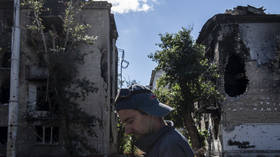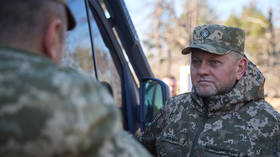Tarik Amar: This is the biggest illusion about the Ukraine war the West refuses to acknowledge
Despite what foreign leaders and commentators say – and really seem to believe – Russia is the one setting the tempo of the conflict
We are living through a remarkable Western anticlimax. The US has finally, after half a year of domestic wrangling, passed another large funding package of $61 billion for Ukraine. This money had been presented as decisive: either it would come through or Kiev would be unable to hold its crumbling frontlines against Russia and would lose the war soon, as Ukrainian President Zelensky himself warned.
That was the minimum sales pitch. The more aggressive hard sell went further, claiming that once the money would be added to a fresh mobilization drive in Ukraine, its re-armed and replenished forces would not only resist Russian pressure but turn the tables and, in the end, perhaps in 2025, win the war.
Both these sales pitches were very unrealistic, as marketing often is. Now that the funding is on its way, reality is reasserting itself. There is no surprise that Russian advances are continuing, while the Ukrainian position keeps deteriorating, as the commander-in-chief of the Ukrainian military, General Syrsky, is admitting.
Of course, those who choose to believe that the additional money will make a substantial difference can argue that, at this point, whatever aid will eventually reach Kiev’s troops on the ground has yet to arrive. Yet there are signs that civilian and military officials with inside knowledge of Ukraine’s situation know that its problems are more profound, and that money will not fix them. That is the most plausible explanation for how rapidly these officials have started lowering expectations.
The most striking examples come from some Ukrainian officers on the frontlines, who under the cover of anonymity, have spoken to the Swiss magazine Blick. Their statements are so bleakly sensational that a major Ukrainian news site has reproduced them – Strana.ua, which has a record of challenging the official messages of the Zelensky regime.
These Ukrainian officers predict that Ukraine will lose the war this year. One of them, serving on the frontline in the strategically critical town of Chasov Yar, foresees that the Donbass region – that is, most of the country’s east – will come under full Russian control by October. At that point, he surmises, Kiev will have to negotiate with Moscow. While he still uses the popular euphemism of a “freeze” and avoids terms such as “capitulation,” under such circumstances these negotiations would clearly amount to a form of surrender. The British magazine The Economist also quoted a commander in Chasov Iar as stating that he and other officers expect the city to fall to Russian forces, despite the promised injection of Western aid.
In general, the officers interviewed by Blick list three reasons why a Ukrainian defeat has become inevitable: First, an irredeemable lack of manpower, since, as they put it, the new mobilization “will not save us.” That is plausible, because Ukrainian units are heavily depleted, as Ukrainian commanders have acknowledged. Any mobilization is about trying to fill gaping holes, not about expanding the forces.
In addition, those Ukrainians willing to fight have already been recruited and quite a few unwilling ones as well: for a long time, Kiev has had to rely on manhunts to scrape together enough “cannon fodder.” This problem is only getting worse. And, finally, those mobilized now also need to be trained. Their lack of consent and motivation will make that hard, while there is not enough time for it in the first place.
Secondly, the Ukrainian officers believe that most of the fresh aid will arrive too late. That fear is well-founded, too, considering the underlying weakness of Western arms industries. This is reflected in the fact that less than 14 out of the 61 billion dollars are really earmarked for supplies to be delivered this year. Much of the rest will restock US arsenals.
The West is capable of releasing some systems and ammunition quickly, which is hyped in the mainstream media, for instance The Economist, as “just in time.” Yet, in a large-scale war of attrition, the real challenge is scale. It is clear that the West cannot provide in sufficient quantities, now and for the foreseeable future. That is why even President Vladimir Zelensky, after a meeting with NATO General Secretary Jens Stoltenberg, publicly stated that he sees no “positive” developments regarding timely support for Ukraine’s military. He cautioned that although money has been allocated, it is one thing “to have funds” and “as important to see what we can get” with them.
The third reason why the Ukrainian officers speaking to Blick believe that Kiev will lose is their own commander-in-chief, Syrsky. They still call him the “butcher,” a nickname he originally earned by his ruthless – and useless – wasting of troops during the battle of Artyomovsk (Bakhmut). Serving under him, the frontline fighters say, has a “paralyzing” effect – on them, not on the Russians. One officer even went as far as to speak of a “genocide of our best soldiers.” Even though Syrsky is a bad commander-in-chief, that is hyperbole. But it is indicative of the low morale of some Ukrainian frontline troops that they use such terms with respect to their own leadership.
In the West as well, we see signals of caution: Parts of the commentariat have started reframing the $61 billion. It is no longer the make-or-break lifesaver of the West’s war effort but simply insufficient. Hugo Dixon, a Reuters columnist, for instance, argues that the aid package can only be the beginning of a longer and, again, much more expensive effort.
Biden administration officials – anonymous just like the skeptical Ukrainian officers – have also publicly doubted that the new aid package will be enough for Ukraine to win.
The key question is what are all these signals about? Are they really meant to lower expectations, preparing, in essence, an exit – at least for the US, if not necessarily the EU – from the Ukraine proxy war fiasco? Or are we witnessing a campaign to prepare the Western public for even longer and deeper engagement? Is Washington preparing to get up from the table and walk or is it doubling down on a very bad and extremely risky game?
There is some evidence pointing to a doubling-down: As part of the same package of laws, the US ramped up its effort to seize Russian state funds. In the US itself, there are only a few billion dollars to grab, but there are hundreds of billions in Europe. That is an extreme act that, in the end, will greatly damage America by further undermining the dollar, as both Russia and China are warning. Yet the aim is obvious: to plunder these Russian assets to secure funding for years of future war in Ukraine.
In addition, some Western politicians and experts believe – or at least say – that Ukraine can buy sufficient time to hold out until more Western industrial resources can be made available for the war effort. In such a long-term scenario, they hope, the West and Ukraine could ultimately turn the logic of attritional warfare against Russia and prevail. Again, that as well, is a strategy – or, rather, wishful thinking – reckoning on years of further war. Indeed, if – a big if – President Vladimir Zelensky is to be trusted, Kiev and the Biden administration are in talks about a security agreement to lock in American support and more money for a decade.
Yet the truth is that we cannot know Washington’s real plans. We cannot even know if it has definite plans. Perhaps, the Biden administration is merely playing for time to reach the election in November without an outright Russian victory. Maybe there are serious intentions to prolong the proxy war. In a worst case, we cannot rule out that the US is ready to escalate to direct war or let the EU and Britain do so. We do know that we cannot assume that American strategies will be rational or responsible.
But here is another thing we do know, even if all too many Western observers – and planners – seem to habitually forget it: Russia also has plans, and its actions and capabilities have shown a clear pattern of defying Western and Ukrainian expectations.
It is Russian actions, adaptation, strategies and tactics that have caused the failure of Western arms in Ukraine, such as missiles (the famed but ultimately strategically ineffective HIMARS, ATACMS, Storm Shadows/SCALPS) and tanks and other armored vehicles (for instance, the equally over-sold Leopard IIs, Abrams, Challengers, and Bradleys which have proven tactically ineffective).
Top-notch as well as less advanced air defense systems (Patriot, NASAM, IRIS-T, Hawk) have fared no better. Even these peak products of the West’s military-industrial complexes have not been the silver bullets they were supposed to be, as the Washington Post has long admitted. They have always been overstretched, incapable of protecting both major cities and military forces. In addition, they are expensive to use and susceptible to being overwhelmed by a mix of simple and technologically advanced drones and missiles – which is precisely what Russia has been doing.
Likewise in the area of mobilization: Ukraine is mobilizing desperately. Russia, as The Economist acknowledges, finds it easier – very much against Western expectations as of the fall of 2022 – to refill and expand its forces. “Ukraine is therefore likely,” the British magazine concludes, “to remain on the back foot, unable to mount new offensives.” The same holds, of course, for Moscow’s war economy, its ability to maintain international alliances and support notwithstanding Western attempts to isolate it, and last but not least, military strategy and tactics.
Whereas Western commentators and leaders often speak – and, it seems, really think – as if their decisions are the key factor deciding how much longer this war will continue and how it will end, the reality is the other way around: The initiative is Russia’s. Those planning for an even longer war – and even those Western critics of Western policies that warn of another “forever war” – are overlooking the obvious: Moscow has a greater say on these matters.
The statements, views and opinions expressed in this column are solely those of the author and do not necessarily represent those of RT.








Comments are closed.